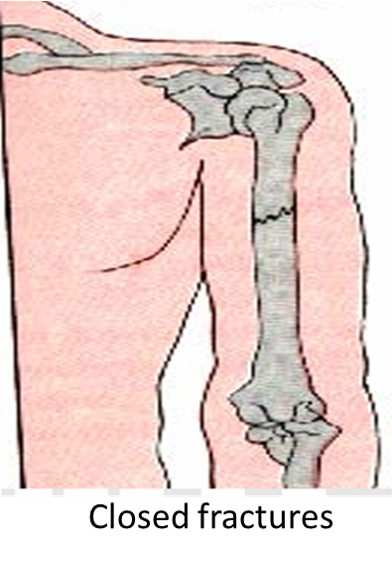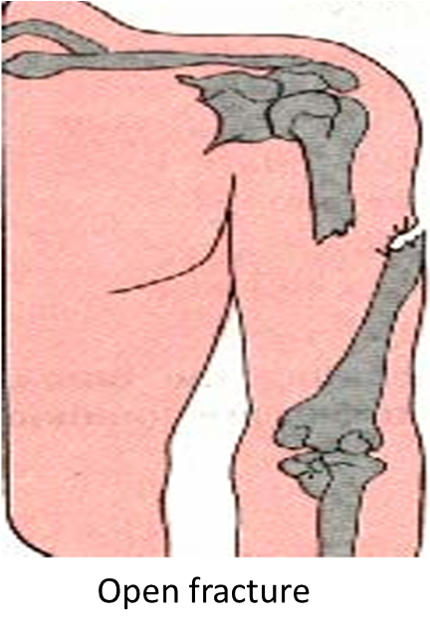Fracture
A fracture is a break or crack in the continuity of bone.
Types of Fracture
Closed fractures– closed (simple) fractures are those not associated with open wounds on the surface of the body.

Open fractures – open (compound) fractures are those associated directly with open wounds.

Causes of Fracture
The most common causes of fractures are motor vehicle accidents or accidents related to falls, recreational and sports activities.
Signs and Symptoms
- The victim may have heard or felt a bone snap.
- Pain, swelling, tenderness and difficulty of moving the injured part.
- Grating sensation of broken bones rubbing together.
- Abnormal movement in an area of the body.
- Difference in shape and length of corresponding bones on the two sides of the body.
- Obvious deformities.
- Discoloration.
First aid principles
- Rescue if necessary and protect against further injury.
- Maintain an open air way and apply artificial respiration if indicated.
- Call for an ambulance or medical assistance if indicated.
- Prevent movements of the injured parts and the adjacent joint.
- Elevate involved extremities if possible without disturbing the suspected fracture.
- Apply splint if ambulance service is not available and if medical assistance for diagnosis and treatment is delayed. If an open fracture is evident or suspected treat the wound as outlined previously and do the following:
- Remove or cut away the victims clothing.
- Control hemorrhage by applying pressure through a large sterile or clear dressing over the wound.
- Don’t wash, or probe or do not insert your fingers in to the wound.
- If a fragment of bone is protruding, cover the entire wound with sterile dressing.
- Do not replace any bone fragments.
Splinting
Splints are metallic, wooden or other devices applied to the arms, legs or trunk to immobilize the injured part when a fracture is suspected. They also protect against further injury during transportation for medical treatment. There are many varieties of splints commercially available and they can also be made locally from different materials.
General principles of splinting
- The splint should be long enough to extend past the joints on either side of a suspected fracture.
- It should be adequately padded between the splint and the skin especially over bony places.
- It can be held in place by stripes of clothes and other available materials.
- Joints must be immobilized above and below the location of the fracture.
- In fractures of arms, check for pulse; inspect the fingers for color and swelling which is good indication for a bandage that is too tight.
- If there is numbness, tingling sensation, or inability to move fingers or toes loosen ties immediately; otherwise permanent nerve damage may result.
- Inform the victim not to move the part below the fracture site.
- Never test for fracture by moving the victim’s broken body part.
- Don’t allow a victim to move his head or don’t move it yourself when possible neck or spine injury is present.
- Straighten and splint a deformed limb as necessary.
Specific Fractures
Scalp Injuries and fracture of the skull
Wounds of the scalp, even if small, tend to profusely bleed. Deep scalp wounds may be complicated by fragment from skull fractures or they may contain hair, glass or other foreign materials.
First Aid Measures
- Do not try to clean scalp wounds.
- Control bleeding by raising the victim’s head and shoulder; do not bend the neck (fracture may be present).
- Place a sterile dressing on the wound.
- Apply a bandage to hold the dressing in place and to provide pressure.
Brain Injury
May occur not only form wounds of the scalp and open or closed fracture of the skull but also in the case of an illness such as a stroke or tumor.
Signs and symptoms
- Temporary or long-lasting loss of consciousness depending upon the severity of the injury.
- Other manifestations of brain injury include:
-
- Partial or complete paralysis of muscle of extremities of the opposite side and facial paralysis on the same side of brain injury.
- Disturbance of speech.
- Local or generalized convulsions.
- Bleeding from the nose, ear canal or mouth, which is indicative of skull fracture.
- Pale or flushed face.
- Fast and weak pulse.
- Headache and dizziness.
- Vomiting.
- Unequal size of pupils.
- Loss of bowel and bladder control.
First aid for suspected brain injury
- Call for ambulance and obtain medical assistance as quickly as possible.
- Keep the victim lying down and treat for shock.
- Give particular attention to insuring an open-air way.
- Control hemorrhage.
- Do not give fluid by mouth to the victim (keep NPO).
- Apply dressing and bandage over the skull if wound is present.
- Record the level of consciousness.
Face and jaw fracture
It often occurs as a result of automobile accidents or other type of violent injuries. The immediate problems are obstruction of the air passage by blood, saliva, and other secretions, swelling and severe hemorrhage.
First aid measures
- Call for ambulance and seek immediate medical assistance.
- Maintain an open air way.
- Provide continues support to the head to prevent air way obstruction.
- If the victim is conscious help to lean foreword to drain secretion from mouth and cough up.
- Give artificial respiration if necessary.
- Treat for shock.
- Apply protective dressing as necessary
